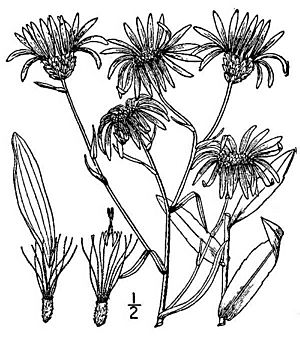Creeping aster facts for kids
Quick facts for kids Creeping aster |
|
|---|---|
 |
|
| A drawing of the flower heads, feathery parts, and leaves | |
| Conservation status | |
| Scientific classification | |
| Synonyms | |
|
The Eurybia surculosa, often called the creeping aster, is a type of plant that lives for many years. It belongs to the daisy family. This plant was once grouped with other aster plants.
You can find the creeping aster in the eastern United States. It likes to grow in sandy soils, especially near the coastal plain. Sometimes, if another similar plant is nearby, it grows further inland. This includes areas like the southern Appalachian Mountains and the Cumberland Plateau.
While the creeping aster is not in serious danger, it is rare in some places. For example, it is considered endangered in Virginia and Alabama. Its flowers are beautiful, with bluish-violet petals and pale yellow centers. These centers later turn a purplish color. The flowers bloom in summer and stay until the fall.
Where Does the Creeping Aster Grow?
The creeping aster is native to the eastern part of the United States. It grows both along the coast and in mountain areas. In the northern parts of its range, it is mostly found near the coast.
Its Favorite Places to Live
This plant usually does not grow in the same spots as a similar plant called E. compacta. If E. compacta is present, the creeping aster tends to stay in inland areas and the mountains.
You can find small groups of creeping asters in Massachusetts and Connecticut. Then, there is a continuous area where they grow from Delaware and Maryland. This range goes south through Virginia, the Carolinas, and into Georgia.
To the west, the creeping aster is found in Alabama, Tennessee, Kentucky, and Ohio. However, it does not grow in West Virginia.
What Kind of Environment Does It Like?
The creeping aster typically grows at elevations from about 200 to 1500 meters (670–5000 feet). It can grow in both dry and wet sandy soils.
Its preferred homes include open spaces, pine forests, and oak scrub areas. You might also see it in clearings, bogs, and along the sides of roads.


